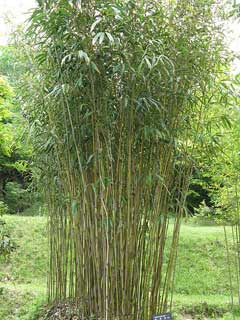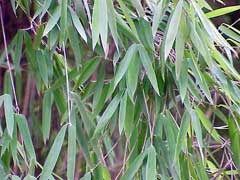 |
|
http://commons.wikimedia.org/wiki/User:KENPEI |
 |
| biolib.de |
Translate this page:
Summary
Physical Characteristics

 Pseudosasa japonica is an evergreen Bamboo growing to 4.5 m (14ft) by 3 m (9ft).
Pseudosasa japonica is an evergreen Bamboo growing to 4.5 m (14ft) by 3 m (9ft).
See above for USDA hardiness. It is hardy to UK zone 6. It is in leaf all year. The species is hermaphrodite (has both male and female organs) and is pollinated by Wind.
Suitable for: light (sandy), medium (loamy) and heavy (clay) soils, prefers well-drained soil and can grow in nutritionally poor soil. Suitable pH: mildly acid, neutral and basic (mildly alkaline) soils. It can grow in full shade (deep woodland) semi-shade (light woodland) or no shade. It prefers moist or wet soil. The plant can tolerate maritime exposure.
UK Hardiness Map
US Hardiness Map
Synonyms
Arundinaria japonica. Arundinaria metake. Bambusa japonica. Bambusa metake. Sasa japonica.
Plant Habitats
Woodland Garden Sunny Edge; Dappled Shade; Shady Edge; not Deep Shade; Hedge; Bog Garden;
Edible Uses
Edible Parts: Seed Shoots Stem
Edible Uses:
Young shoots - cooked[2, 105, 177]. Harvested in the late spring when about 8 - 10cm above ground level, cutting the stems 5cm or more below soil level. They have a rather bitter flavour[K]. Seed - used as a cereal[105]. Small quantities of seed are produced in many years but it is seldom viable.
References More on Edible Uses
Medicinal Uses
Plants For A Future can not take any responsibility for any adverse effects from the use of plants. Always seek advice from a professional before using a plant medicinally.
Abortifacient Anthelmintic Antivinous Aphrodisiac Stimulant Tonic
Anthelmintic, antivinous, stimulant, tonic[178]. Used orally in Chinese medicine for asthma, coughs and gallbladder disorders. In India leaves are used for spasmodic disorders of the stomach and to arrest bleeding [301]. Leaves used as a aphrodisiac [301].
References More on Medicinal Uses
The Bookshop: Edible Plant Books
Our Latest books on Perennial Plants For Food Forests and Permaculture Gardens in paperback or digital formats.

Edible Tropical Plants
Food Forest Plants for Hotter Conditions: 250+ Plants For Tropical Food Forests & Permaculture Gardens.
More

Edible Temperate Plants
Plants for Your Food Forest: 500 Plants for Temperate Food Forests & Permaculture Gardens.
More

More Books
PFAF have eight books available in paperback and digital formats. Browse the shop for more information.
Shop Now
Other Uses
Hedge Hedge Plant support Soil stabilization
Plants can be grown along the river edge to protect the banks from erosion[195]. Canes are fairly thin walled but make very good plant supports[25, 75, 195]. Smaller canes can be plaited together and used as screens or as lathes for walls and ceilings[195]. Tolerant of maritime exposure, it can be grown as a screen or windbreak hedge in very exposed positions[75, 166]. The culms make an excellent wind filter, slowing its speed without creating turbulence. The leaves may look somewhat tattered by the end of the winter but plants will soon produce new leaves[K].
Special Uses
Food Forest Hedge Hedge
References More on Other Uses
Cultivation details
One of the easiest bamboos to grow in Britain, it prefers an open loam of fair quality and a position sheltered from cold drying winds[1, 11, 29] but it tolerates maritime exposure[75, 166]. Succeeds on peaty soils[11]. Succeeds in soils that are half earth and half stone[195]. Requires abundant moisture and plenty of organic matter in the soil[200]. Endures near-saturated soil conditions[200]. Dislikes drought[1]. A very ornamental plant[1], it is said to be the hardiest bamboo[25], tolerating temperatures down to about -15°c[200]. Down to -24°c according to another report. In warmer parts of Britain plants can attain a height of 6 metres or more. The rootstock is running and very invasive[25]. It is fairly easy to control, however, if any new shoots that are not wanted are broken off whilst they are still small and brittle. New shoots appear from April[25]. This species is notably resistant to honey fungus[200]. Plants often flower lightly for a number of years without dying out though they seldom produce viable seed[122]. Occasionally the plants can produce an abundance of flowers and this severely weakens, though does not usually kill, the plants. They can take some years to recover. If fed with artificial NPK fertilizers at this time the plants are more likely to die[122]. Many plants flowered heavily in the late 1980's and are only slowly recovering.
References Carbon Farming Information and Carbon Sequestration Information
Temperature Converter
Type a value in the Celsius field to convert the value to Fahrenheit:
Fahrenheit:
The PFAF Bookshop
Plants For A Future have a number of books available in paperback and digital form. Book titles include Edible Plants, Edible Perennials, Edible Trees,Edible Shrubs, Woodland Gardening, and Temperate Food Forest Plants. Our new book is Food Forest Plants For Hotter Conditions (Tropical and Sub-Tropical).
Shop Now
Plant Propagation
Seed - if possible, surface sow the seed as soon as it is ripe in a greenhouse at about 20°c. Stored seed is best sown as soon as it is obtained. Do not allow the compost to dry out. Germination usually takes place fairly quickly so long as the seed is of good quality, though it can take 3 - 6 months. Prick out the seedlings when they are large enough to handle and grow them on in a lightly shaded place in the greenhouse until they are large enough to plant out, which might take a few years. Plants only flower at intervals of several years and so seed is rarely available. Division in late spring as new growth commences. Very easy, single canes of the current years growth can be used. Pot them up in light shade in a greenhouse. Make sure the foliage is not allowed to dry out - misting 2 - 3 times a day for the first couple of weeks following division can be very helpful. Plant out in the summer once they are growing away strongly. Cane layering in May. Detach individual canes and lay them horizontally in trenches 15cm deep. New shoots should arise from each joint. Rhizome cuttings.
Other Names
If available other names are mentioned here
Native Range
Coming Soon
Weed Potential
Right plant wrong place. We are currently updating this section.
Please note that a plant may be invasive in one area but may not in your area so it's worth checking.
Conservation Status
IUCN Red List of Threatened Plants Status :

Growth: S = slow M = medium F = fast. Soil: L = light (sandy) M = medium H = heavy (clay). pH: A = acid N = neutral B = basic (alkaline). Shade: F = full shade S = semi-shade N = no shade. Moisture: D = dry M = Moist We = wet Wa = water.
Now available:
Food Forest Plants for Mediterranean Conditions
350+ Perennial Plants For Mediterranean and Drier Food Forests and Permaculture Gardens.
[Paperback and eBook]
This is the third in Plants For A Future's series of plant guides for food forests tailored to
specific climate zones. Following volumes on temperate and tropical ecosystems, this book focuses
on species suited to Mediterranean conditions—regions with hot, dry summers and cool, wet winters,
often facing the added challenge of climate change.
Read More
Expert comment
Author
(Siebold.&Zucc. ex Steud.)Makino. ex Nakai.
Botanical References
1158200
Links / References
For a list of references used on this page please go here
Readers comment
| Add a comment |
|
If you have important information about this plant that may help other users please add a comment or link below. Only comments or links that are felt to be directly relevant to a plant will be included. If you think a comment/link or information contained on this page is inaccurate or misleading we would welcome your feedback at [email protected]. If you have questions about a plant please use the Forum on this website as we do not have the resources to answer questions ourselves.
* Please note: the comments by website users are not necessarily those held by PFAF and may give misleading or inaccurate information.
To leave a comment please Register or login here All comments need to be approved so will not appear immediately.
|
Subject : Pseudosasa japonica
|
|
|
|